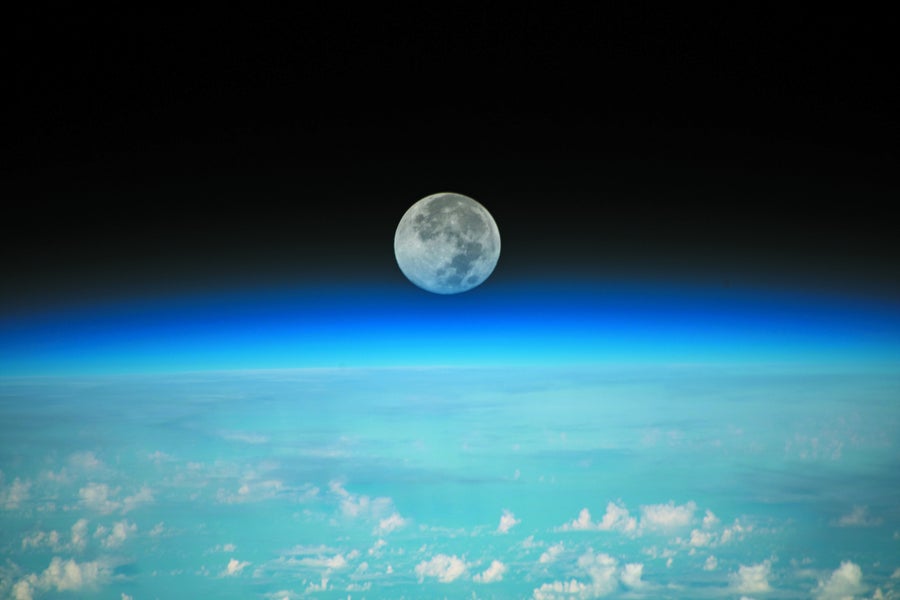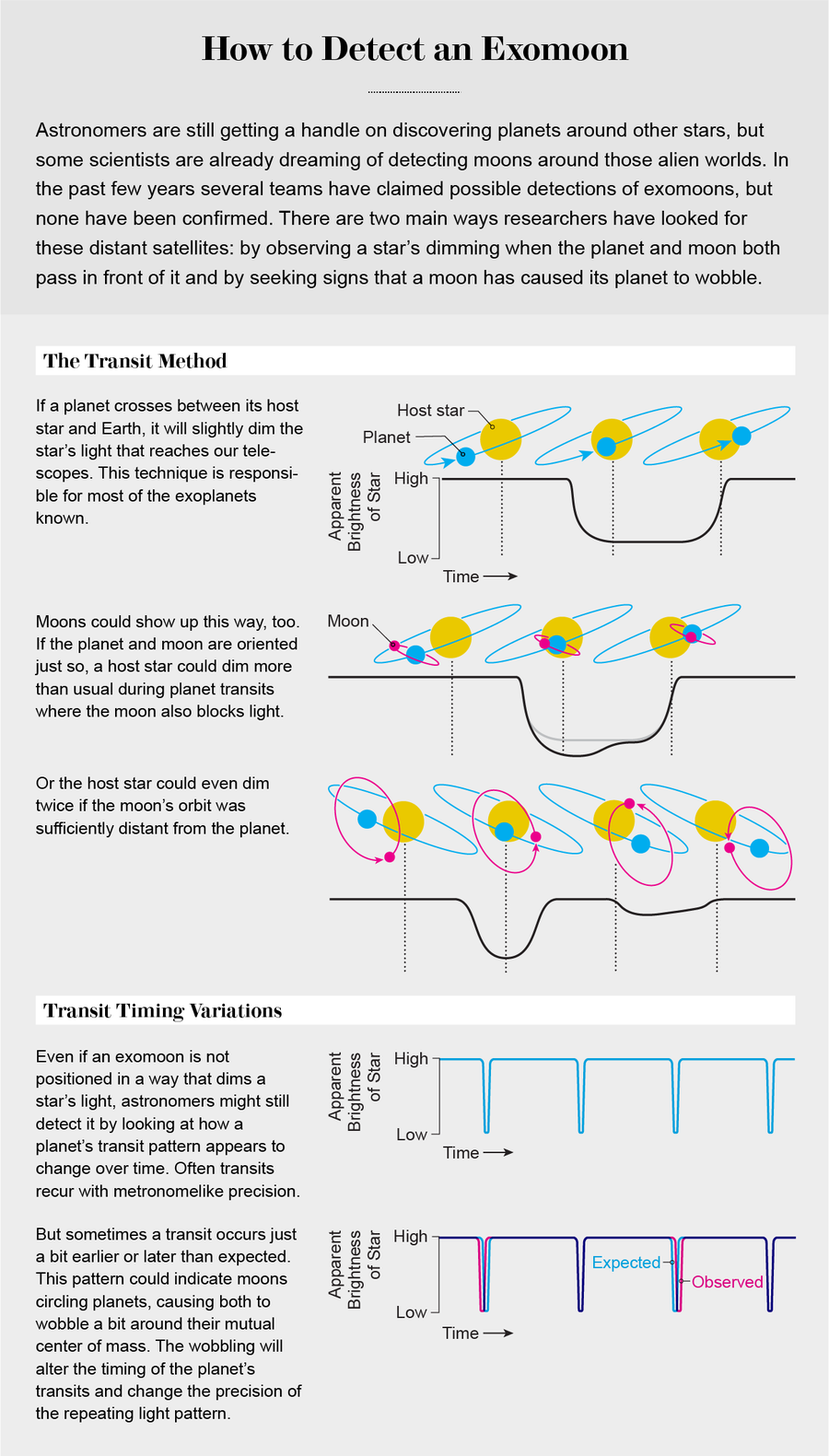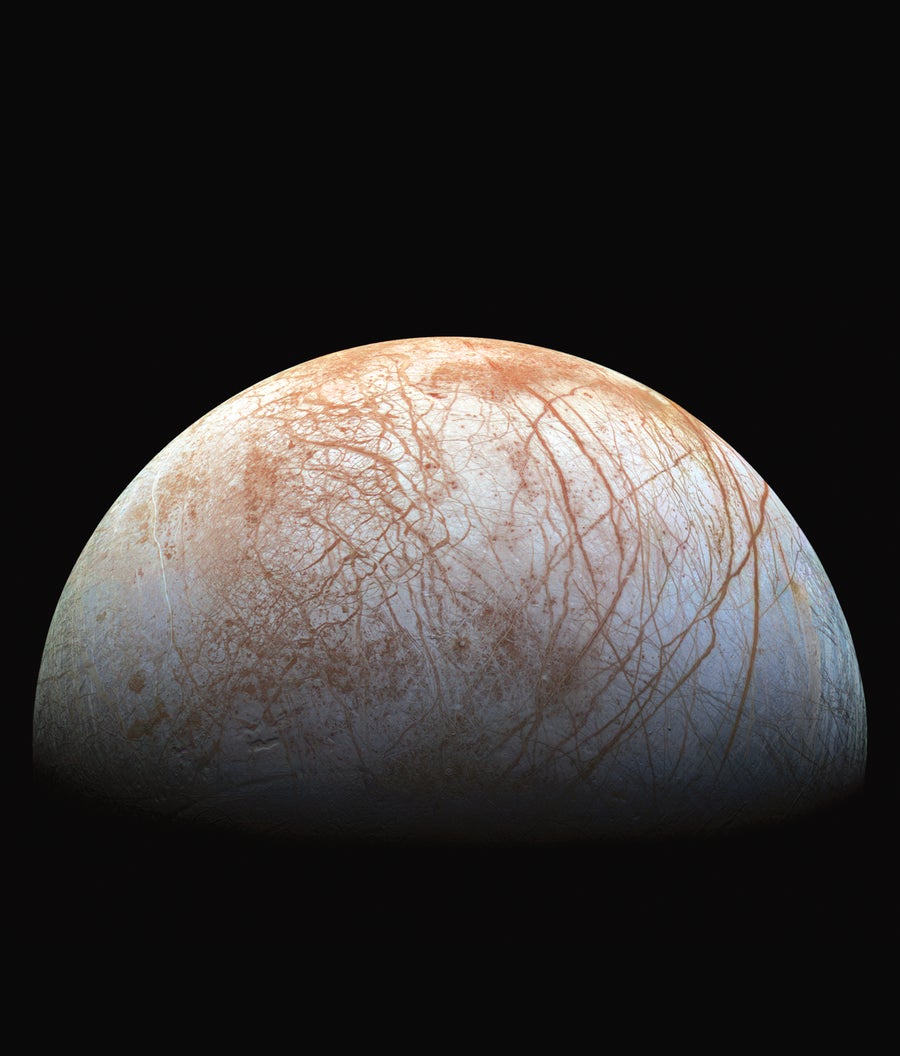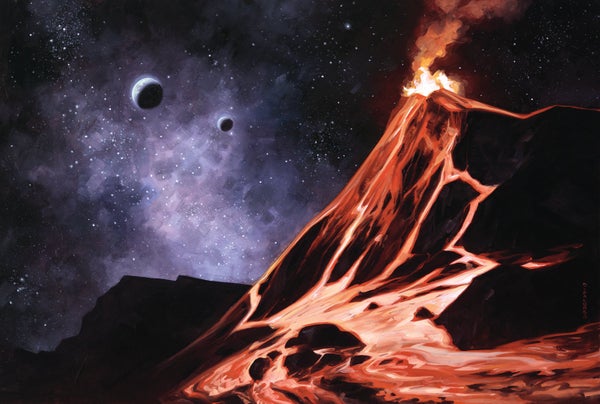In 2007 a network of automated telescopes observed a star about 433 light-years away in the constellation Centaurus. The star dimmed noticeably for at least 54 days, with its feeblest light measured around April 29. In 2012 astronomers determined that this star hosted a huge, Saturn-size gaseous planet orbited by a spectacular array of 37 rings. Just as Saturn does, this world known as J1407b has a gap in its ring system. Scientists suggested the gap may indicate a moon with roughly the mass of Earth.
Until the end of the 20th century, the only known planets were the seven worlds with which Earth shares the sun. This situation changed with the earliest exoplanet discoveries in the late 1990s and was completely overturned starting in 2009, when the Kepler space telescope opened its lens. We now know that the cosmos is peppered with planets, that there are far more planets than stars, and that these worlds come in almost every imaginable size, location and type. Arguably for the first time since the days of Galileo Galilei, discoverer of Jupiter’s largest moons, and astronomers such as Huygens himself, humans are seeing our place in the universe with fresh eyes. We have yet to find a distant planet that looks just like home or to confirm that an exoplanet is orbited by a moon of its own. But we are getting closer.
Astronomers began speculating about exomoons in the early 2000s, after several exoplanets began winking into distant starlight, and searches since 2018 have turned up a few promising candidates. Locating a moon outside our solar system would mark another reorientation of our cosmic perspective. We will learn whether moons are ubiquitous or rare; whether they are usually large or small, compared with their planets; whether they often form along with their planets or are created in later cataclysms; and whether they come in groups or typically fly solo. We will be able to understand whether our solar system is unique and whether Earth and its solitary, huge moon stand alone.
On supporting science journalism
If you're enjoying this article, consider supporting our award-winning journalism by subscribing. By purchasing a subscription you are helping to ensure the future of impactful stories about the discoveries and ideas shaping our world today.
“Every time we see an exoplanet, I think it’s a mirror on our own history,” says Alex Teachey, a postdoctoral researcher at the Academia Sinica Institute of Astronomy and Astrophysics in Taiwan and co-discoverer of a possible exomoon of the exoplanet Kepler-1625b. “In what ways are we common and in what ways are we uncommon? Just as we started seeing with exotic exoplanet systems, we could be surprised in what we see with exomoons as well.”
The Perks of a Moon
Earth remains unique, in this solar system and everywhere else we have looked so far. It is the only planet known to harbor life. It is the only planet whose active innards sculpt its outer face, in the form of plate tectonics, a process that itself plays a role in the dispersal and evolution of life. It is the only planet with an atmosphere thick enough to support liquid water, a climate that has remained stable for millennia and a just-right distance from its sun that keeps it warm but not too hot. These conditions exist at least in part because of Earth’s moon.
The moon’s role in Earth’s history goes back to the very beginning, some 4.5 billion years ago, when a planet the size of present-day Mars collided with the infant Earth. The cataclysm left behind an incandescent, oblong Earth and a boiling moon. The moon has been cooling and moving away from Earth ever since. The planet became more spherical as the moon began to recede, and Earth’s crust flexed under the resulting tidal force. The early crust deformed, possibly causing the onset of tectonics. The moon’s recession also slows Earth’s spin, lengthening our day by almost two milliseconds every century.
The moon’s heft is significant relative to Earth’s; our planet’s mass is only 81 times greater than that of our satellite, a ratio many times smaller than for the other moons of our solar system. Saturn, for instance, outweighs Titan 4,200-fold. The moon’s pull guards Earth’s axis, keeping the planet near a constant 23.5-degree tilt with respect to the sun. This configuration protects Earth’s climate over millennia, as opposed to Mars, which lacks sizable moons and thus wobbles on its axis between zero and 60 degrees at the extremes every few million years—a change that drives dramatic climatic shifts. The moon provides the primary influence over Earth’s tides, which shape coastlines and the life in the oceans. Our moon’s tides most likely played a role in evolution, shepherding the first plants and tetrapods from the salty marshes of the coasts and onto land.

Earth’s moon, seen here from the International Space Station, has shaped the history of our planet and helped make it habitable for life. Credit: NASA
The moon is more than a silent, spectral satellite; it is a world unto itself, which Earth’s occupants have both used and contemplated since the first sighted beings looked skyward. Earth would not be Earth without the moon. Neither would the oceans, or poetry, or religion, or science, or any of us.
If Earth’s singular past provides any prologue, exoplanets might be different without moons, too. Unmooned exoplanets might be lifeless rocks, doomed to tilt like Mars through the millennia, freezing or boiling and preventing atmospheres and life from holding on. Exomoons themselves, if they exist, might even be better places for life than their planets. The search for life beyond our solar system may need to focus on planets with the possibility of moons and even on the moons themselves.
Although Huygens could not have known it, his Titan, an orange ball of haze dotted with methane and ethane rivers and lakes, is quite planetlike. It would not be hospitable to us or any life we would recognize, but it contains liquid and an atmosphere, meaning it contains a chance for mixing of ingredients and a chance for life. Saturn, with its intense gravity and clouds of ammonia, would never be a safe haven for life; the same scenario exists for Jupiter, practically a half-star with absurd radiation belts and gas layers that would be fatal to us. But the same cannot be said of their moons.
“Because of our solar system, we know Jupiters can have significantly large moons that can have water,” says Chris Fox, a graduate student at Western University in Ontario. “If you have a Jupiter in the habitable zone of its star, you could see a moon that is like Earth, and the moon may have life. Given the number of moons that there [likely] are, maybe life on moons is even more common than life on planets.”
Exomoons, in other words, may be habitable themselves, and they might help make their host planets habitable, too. Finding them will bring us closer to understanding those worlds as well as our own.
An Intriguing Candidate
Astronomers suspected the cosmos was full of worlds and their moons long before the Kepler telescope saw its first light. In 1999 Paola Sartoretti and Jean Schneider, now both at the Paris Observatory, became the first to propose searching for exomoons using the transit method.
If a star and its planets are arrayed on a flat plane as viewed from Earth—as if you were looking at the solar system from the side rather than the top down—the star will appear to dim for a brief period because a planet has moved in front of it. This eclipselike frontal pass is called a transit. When transits repeat on a regular schedule, you can usually be confident an orbiting planet is causing the dimming. The Kepler telescope used this method to find planets for a decade. Sartoretti and Schneider argued that moons orbiting at wide distances from their host planets would be detectable in this way, too, if the moon were beside the planet at the time of the transit. A host star could dim more than usual or could even dim twice if the moon’s orbit were sufficiently distant from the planet. If you were standing on the planet during the transit, for widely separated moons, the moon’s phase would have to be near first or last quarter; a full moon or new moon, when the moon is directly opposed to the star, would not make a discernible dent in the planet’s transit.
Even if exomoons orbited close to their host planets, making a secondary dimming implausible, astronomers might still detect moons by looking at how a planet’s repeating transit pattern appears to change over time, Sartoretti and Schneider suggested. Often transits recur with metronomelike precision. But sometimes they are a little off, with a transit beginning or ending just a bit earlier or later than scientists predict—an effect called transit timing variation. This can happen because other planets orbit the star and tug on one another, but it can also happen when a planet is hosting a large moon.
To understand why, it helps to understand that Earth’s moon does not orbit our planet exactly. Rather both bodies orbit their mutual center of mass, called a barycenter. The barycenter is still located on Earth because the planet is more massive than the moon. (To be precise, the barycenter is located in Earth, in the mantle, offset from Earth’s gravitational center.) As a result, Earth wobbles very slightly as it orbits the sun. This wobble is one thing Sartoretti and Schneider recommended looking for.
In 2017 Teachey and David Kipping, an astronomer at Columbia University, sifted through data from the Kepler telescope to look for any indications of a moon interfering with the star’s light. They analyzed some 300 planets, hoping to find a population of moons. They found just one candidate: Kepler-1625b.
They applied for time on the Hubble Space Telescope and were surprised when they got it, both recalled. Then they studied the Hubble data for a year, with part of that time spent learning how to use them. When Kipping and Teachey finished their analysis, their Hubble observations showed that the planet’s transit began sooner than it should have, implying a moon was by its side. The planet’s transit time varied by about 20 minutes in five years of data. “We know there’s something pushing that planet around,” Kipping says, “and we think it’s a moon.”

Credit: Jen Christiansen
Teachey and Kipping posted their paper to a preprint server in early 2018, and it was ultimately published in October 2018 in Science Advances. They say the evidence supports the existence of a Neptune-sized moon around Kepler-1625b, which itself is many times the size of Jupiter. Kipping and Teachey stopped short of claiming a discovery. “I think people were frustrated by the way we reported it,” Teachey says. “People thought we were both trying to get credit for a discovery but also kind of covering our rear because we’re not fully claiming it. I understand people’s frustration—is it there or not there? But there’s a lot of unknown unknowns.”
Immediately following their initial announcement, other astronomers jumped into the fray. René Heller, an astronomer at the Max Planck Institute for Solar System Research in Göttingen, Germany, replicated part of Teachey’s findings but found insufficient evidence for a moon. Laura Kreidberg, who studies exoplanet atmospheres, was unable to confirm a key part of the results. Kreidberg, now director of the new Atmospheric Physics of Exoplanets Department at the Max Planck Institute for Astronomy in Heidelberg, Germany, recalled having a friendly but somewhat awkward conversation with Teachey a few months after his paper published. “Alex worked so hard on this, and I don’t want to minimize what he did,” she recounted. “I sort of swooped in there with a bunch of years of experience using this instrument. I’m rooting for Alex. Both of us want the moon to be there. I mean, how cool would that be?”
The Race
Exomoon attention only grew in the months after Kipping and Teachey’s announcement. Soon teams of researchers were poring over Kepler data on their own, trying to find transit variations that could indicate moons. Others turned to instruments such as the Very Large Telescope’s Spectro-Polarimetric High-contrast Exoplanet REsearch tool (SPHERE). Cecilia Lazzoni, currently a postdoctoral fellow at the University of Exeter in England, claimed finding a giant exomoon using a SPHERE survey. In a paper published in Astronomy & Astrophysics, she described it as a companion to a very low-mass brown dwarf, a dim object between a planet and a star that does not fuse hydrogen but is many times the size of Jupiter. Lazzoni’s world and its accompanying body may be more like binary giant planets than a world and a moon. If such objects are common, astronomers will have to grapple with how to define what constitutes a planet and a moon.
In 2019, Phil Sutton of the University of Lincoln in England reanalyzed the super-Saturn, J1407b. The planet and its rings were first discovered by Eric Mamajek, now at the NASA Jet Propulsion Laboratory, and several colleagues. Sutton wanted to find evidence for moons that orbit outside the ring, as most of Saturn’s do, so he set out to determine whether J1407b’s 37 rings are sculpted in the same way. He could not find any evidence for external moons guiding the gaps in the rings and instead found that an external moon would likely shred the disk apart. “We all get excited that we might have actually found something,” Sutton says, but reanalysis often dampens hopes. “It’s just really tricky to confirm.”
Then, in the summer of 2020, Fox, the Western University grad student, peered through more Kepler data. He and his adviser, Paul Wiegert, scrutinized 13 Kepler planets and found eight with transit timing variations that can be explained by exomoons. But, as Fox pointed out, the variations could be something else, too; the possibilities range from stellar activity such as flares to other planets. “In many cases, we were able to match the transit timing variation pattern with a moon, but in all the cases, we could explain them by the presence of a second planet,” he says.
Teachey was critical of the work when Fox posted it to a preprint server that summer and equally critical of coverage that claimed Fox was describing moons when he really described moon-or-planet scenarios. In a young and rapidly growing field, especially one with high stakes for career-making discoveries, some growing pains are inevitable, Teachey says. “We’re not trying to stifle people working on moons, and we don’t want to come across like we’re being gatekeepers,” he says. “But at the same time, this is part of the game. We’re going to call into question conclusions that in our view are not supported by the evidence.” Fox’s paper was published in 2021 in Monthly Notices of the Royal Astronomical Society.
In November 2020 Kipping hosted the first-ever exomoon meeting, an informal conference held over Zoom that brought together some 80 researchers from around the world. The scientists discussed new detection methods, theories for moon and exo-ring formation, new constraints on exomoon sizes and candidates, and related subjects. “I think we need to be a little more organized as a community to have a better shot,” Kipping says.
A definitive detection remains elusive in part because the astronomers are all asking so much of their telescopes and their data. The wee blip in brightness that results from a planet transiting its star can be hard enough to see on its own. Comparing that with a shift in transit timing by just a few moments—remembering that the objects in question are hundreds of light-years away—is an excruciatingly exacting measurement.
Kreidberg says she is frustrated that she was unable to figure out why she and Teachey could not reach the same answer, using the same Hubble data. They shared each other’s processing methods, and she tried to closely replicate his steps but could not reconcile the findings. “My only regret is that we weren’t able to figure out what the difference was,” she says. “The takeaway for me was, we are really pushing the limits of what Hubble can do. It was designed to look at faint distant galaxies, not nearby planets with moons. We’re doing the best we can with data processing, but it’s a fine art to pull the signal out.”
Other challenges are geometric. Because of Kepler’s laws (that is, Johannes Kepler, who discovered the rules governing planetary motion and for whom the planet-hunting telescope is named) and Newton’s laws, moons’ orbits are more stable within a certain distance from their planets, known as the Hill radius. The closer a planet orbits to its star, the likelier that the star’s gravity will interrupt the moon’s orbit, potentially sending it spiraling into the planet or out of the star system entirely. But the data from Kepler, Hubble and other observatories usually capture planets that orbit near their stars—often very near, closer than even Mercury is to the sun. Although these planets are relatively easier to find than planets farther away, they may be more likely to be moonless. “If we’re looking at planets that are transiting their stars, we are looking at planets whose gravitational influence has been severely diminished and are less likely to host a moon,” says Stephen Kane, a planetary astrophysicist at the University of California, Riverside. He published a paper in 2017 arguing that compact planetary systems, such as the TRAPPIST-1 system of seven terrestrial planets, are unlikely to host any moons at all.
Planets that wind up at greater distances from their stars, such as Jupiter and Saturn, are more likely to host moons, notes Alice Quillen, an astronomer at the University of Rochester, who has studied the super-Saturn J1407b. When a planet is more distant from the star, the star is less likely to fuss with the planet’s gravity, allowing a moon to stay in place. If far-flung exoplanets resemble the solar system’s own outer worlds in size and composition, they may also be likelier to grab planetary crumbs, errant asteroids and dwarf planets. Neptune’s moon Triton is thought to be a captured dwarf planet from the distant Kuiper belt, a small world like Pluto, that was swept into Neptune’s embrace after the solar system formed.

JUPITER'S moon Europa harbors a buried ocean that might be hospitable to life. Credit: NASA, JPL-CalTech and SETI Institute
But large, distant planets are hard to find, partly because they take a long time to orbit their stars—one year on Jupiter, equaling one transit, takes almost 12 Earth years, meaning astronomers would have to watch such a planet for more than two decades before finding a definitive signal. And they are hard to spot because they can be confused with other objects. Periodic dims in a star’s constant light are as likely to be caused by star pairs that occasionally move in front of each other as outer planets. “You can’t find things in outer solar systems because it is too easy to confuse with eclipsing binaries,” Quillen says. “You have to spend a lot of time trying to get rid of stuff that isn’t what you want.”
Stars themselves can also confuse the signals. The sun turns out to be a particularly quiescent star; other stars tend to be more active, churning out flares and radiation and developing spots that can also affect their apparent brightness. “The trouble with measuring the brightness of a star is that if you improve the precision too much further, you start to run into stellar activity,” Kane says. “Stars will produce noise that is comparable or even greater than the signal expected from a moon. It essentially creates a ceiling you can’t rise beyond, and that’s a really big challenge.”
Undaunted, some astronomers are turning to creative mathematical and observational methods. Apurva Oza, a lecturer at the University of Bern in Switzerland, is looking for an Io. The Jovian volcanic moon is visible with binoculars or a modest telescope; it is one of the four satellites Galileo Galilei observed in 1609. But viewed with sensitive instruments, Io is one of the most glaringly obvious objects in the sky. It positively emanates sodium and potassium, which it spews into space in vast quantities as Jupiter’s gravity rends its innards and Io’s volcanoes erupt. Io’s exosphere can extend up to 500 times Jupiter’s radius, Oza says. What is more, its signature would be visible no matter where the moon is located; an astronomer studying a transiting planet would not have to worry about the exomoon’s phase. An exo-Io could be behind the planet, and its vast plasma cloud would still be detectable with the right instruments. “If you spray that gas everywhere, you just enshroud it, and you’ll see it during transit,” Oza says.
Spectrographs on several telescopes can already detect volatile gases within and around stars, he adds. Some have detected sodium, potassium and other signatures, which are often unexplained. “The missing factor could be a moon,” Oza says. “It doesn’t seem that outlandish when you think about it that way.” He notes that an exo-Io would hardly be a place to look for any exobiology, however: “We’re not looking for habitability here. We’re looking for explosive environments, which is most of the universe.”
The Way Forward
Astronomers hope the James Webb Space Telescope, which launched in December 2021, will be able to hunt for exomoons with greater precision. Kepler was designed to find Earth-sized planets around sunlike stars, so objects smaller than Earth can be difficult to pick out. Researchers frequently used the Spitzer Space Telescope, but it was retired in January 2020. Not much else on Earth or in the heavens can find exomoons at the moment, so astronomers are relying on better data-processing methods—and getting ready to wait.
“Part of our job remains not just looking for these things but coming up with better ways to look for them,” Teachey says. “People think a discovery is a eureka moment. And it’s more like, ‘Let’s see if it fails this test. And this test.’ Then you’re like, ‘Well, it’s kind of holding up.’”
Ground-based observatories such as the Extremely Large Telescope, under construction in Chile’s Atacama Desert, could also spot exomoons under the right circumstances. The European space telescope PLAnetary Transits and Oscillations of stars (PLATO), set to launch in 2026, could help the search, too. Further into the future, satellites such as the Large UV/Optical/IR Surveyor (LUVOIR)—which might launch sometime in the mid-2030s—could provide excellent exomoon-hunting capabilities. But all these projects are still years away.
“With exomoons, it’s kind of Hubble or bust right now,” until James Webb gets going, Kipping says. In the meantime, he hopes the burgeoning exomoon community will continue figuring out new strategies for working with the data that exist so far. Kreidberg is also hopeful that James Webb will find exomoon signals but concedes that a definitive discovery may still be a while off.
“This is the cutting edge,” Kreidberg says. “Figuring out what we know and how well we know it is an evolving process. You have to be an optimist to work on exoplanets.” And, maybe, exomoons.

